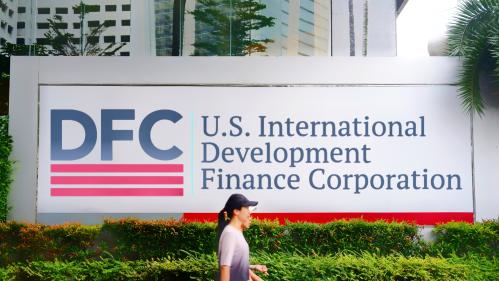The calamity in Haiti is a reminder that the tragedy of disasters is not natural, but manmade. The loss of life that officials now estimate to be between 100,000 to 200,000 would place the Haitian quake as the 7th most deadly earthquake in history. It is no accident that all disasters with the greatest loss of life are in poor areas. When disasters strike poor countries, they kill people; when they strike rich countries, they damage property.
The unfortunate truth is that the poor are the most vulnerable. They live in disaster-prone locations and poorly-constructed dwellings. In Haiti, as elsewhere, richer neighborhoods in Pétionville suffered far less than poorer areas in Port-au-Prince. Because of the strong link between disaster and poverty, the global aid community embarked on a program of “building back better” after the Indian Ocean Tsunami in 2004. If a similarly ambitious program is designed for Haiti, the Indonesian tsunami recovery can provide valuable lessons:
1. Establish a Haiti Reconstruction Agency
Coordination of aid is critical in the reconstruction and development phases that follow relief operations. Such coordination is best done by a national authority that has top-quality individuals and can start from scratch in developing procurement, financial management and human resource practices that satisfy donors and can get the job done.
There are hundreds of volunteer organizations and governments focused to help Haiti. Large or small, all have resources and expertise to offer. But leaving each organization to help in its own way is a recipe for disaster.
After the tsunami in Indonesia, there were so many organizations in Aceh trying to reconstruct houses that a shortage of building materials arose and a spike in construction costs resulted. Over time, more and more affected people were also included on lists of those who were eligible for new housing, and the inflation in housing construction dramatically diminished the purchasing power of international aid money.
It also became apparent that rebuilding houses could not simply offset the devastation. Many socioeconomic issues had to be tackled. A list of beneficiaries was needed to limit assistance to those whose dwellings had been destroyed. Land titles had to be established. Some NGOs offered larger, better houses than others creating inequity among recipients and major social problems. Common standards had to be developed, while retaining enough flexibility to accommodate large differences in household sizes and preferences. And of course, infrastructure connections of water, sewerage and electricity were needed.
For Haiti, the best option would be to create a Haiti Reconstruction Agency. Such an agency would monitor and record all proposed projects, create a forum for discussion of key issues and interchange of ideas, prepare reports on needs and resources by sector, and act as a common funnel for funding and management of pooled aid resources. Ideally, the HRA should also have a sunset clause, of perhaps five years, so that the sense of urgency that is so palpable today is maintained through the reconstruction period. The HRA would naturally play the leadership role on behalf of the government of Haiti with respect to all public and private foreign donors.
Such an agency also has to manage expectations. In Aceh, it took four years to get over 90 percent of the affected population out of temporary shelters and into new homes. It is unlikely that a faster pace will be achieved in Haiti despite best efforts, given the poor implementation capacity in the country.
2. Focus on livelihoods and jobs
It is tempting after an earthquake to focus on infrastructure reconstruction. That kind of hard infrastructure is vital, but not sufficient. The vulnerability lies within the poverty of the people, and that can only be addressed by paying adequate attention to jobs and livelihoods. The tragedy of Haiti is that before the earthquake, 56 percent of the population lived on less than $1 per day, and three-quarters of the population described their economic situation as bad or worse.
In Aceh, the official aid agencies concentrated their projects in infrastructure, while NGOs largely funded social sectors and housing. Productive sectors and activities were left unaddressed. Banking and finance was left in ruins and credit was in short supply.
There will be a short-term boom in construction in Haiti, but many poor people will be left without jobs. Getting credit flowing and recreating an infrastructure for small retail activity, for fishing and agriculture are vital activities. Even before the earthquake, more than half of Haiti’s requested funds for poverty reduction were to be targeted at economic growth. This aspect cannot be forgotten despite the pressures for immediate relief.
Haiti already has its own Growth and Poverty Reduction Strategy Paper, developed in 2007, which puts an emphasis on the restoration of growth and spells out specific programs to achieve it. Doubtless, some priorities will change—it is unlikely that tourism will be restored at the envisaged rate, for example. But the elements of a development strategy are there. At its core is a concept of local development schemes and land management at the level of arrondissements, boroughs and communities. These plans need to be urgently revisited.
Plans to revive economic growth cannot be implemented if aid is volatile and unpredictable. In 1995, Haiti received $135 per person in official development assistance. By 2002, aid had fallen to $26 per head. After a new government was elected, aid began to increase again and sanctions were lifted; but even after the hurricanes of 2008, aid only recovered to $100 per person. Economic recovery cannot happen in the face of such a high degree of aid volatility. If aid remained at 1995 levels in 2002, it would have directly added one-quarter to Haiti’s gross national income, and a multiple of that when indirect, multiplier effects are taken into account. Haiti needs a multi-year, multi-donor trust fund for reconstruction modeled after the successful one implemented in Aceh.
3. Maintain transparency
With many groups rushing to provide aid, it is imperative to develop systems to track efforts. Transparency is the only way to ensure that citizen groups can participate in the monitoring of aid activities. It will help reduce corruption in implementation. It can identify which sectors are overfunded compared to needs, and which are chronically underfunded. It can help maintain a sense of urgency over project implementation.
When NGOs, which are not used to systematic reporting of their activities, are a large part of the equation, it is all the more important to develop transparent information systems. In Aceh, the government mandated all NGOs to provide a short concept note, outlining their project. It also developed a simple, manual financial tracking system to monitor monthly tracking of spending on all projects. Haiti needs a similar system. The more sophisticated computer-based system failed to capture most information due to lags and errors in filling out the required entries.
But transparency does not happen by itself. It needs a systematic effort by a designated institution, such as a Haiti Reconstruction Agency, as well as acceptance and cooperation by all development partners.



Commentary
Op-ed“Build Back Better” in Haiti: Lessons from the Indonesian Tsunami
January 21, 2010